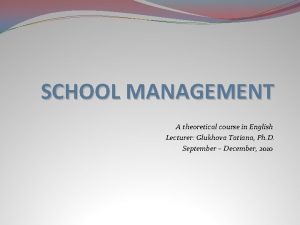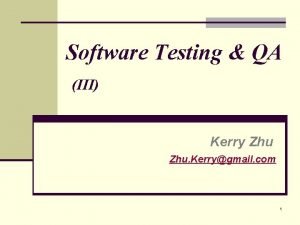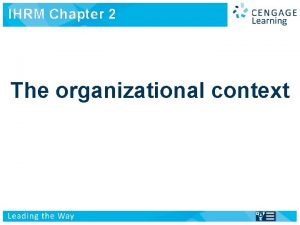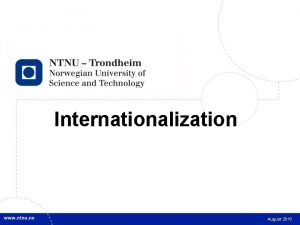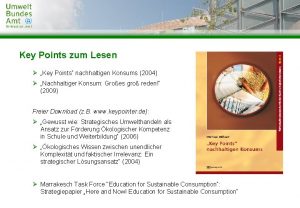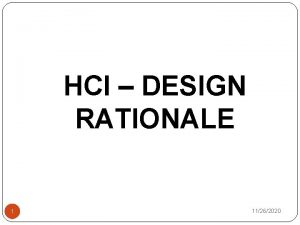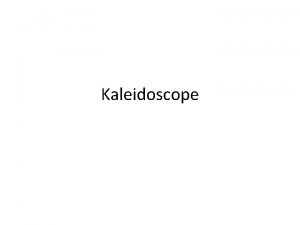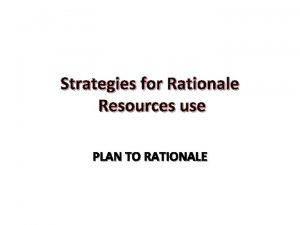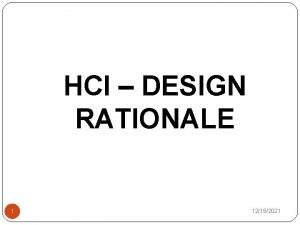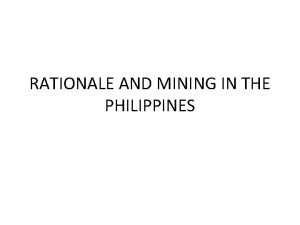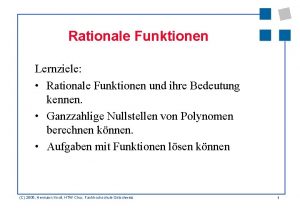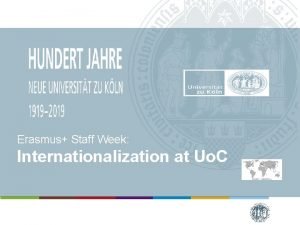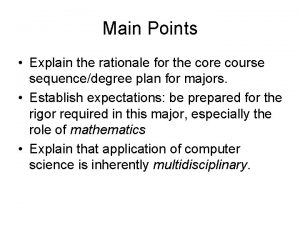1 The Internationalization Process Chapter Key Points Rationale


























- Slides: 26

1 The Internationalization Process Chapter Key Points Rationale Process Dimensions Course Content Overview

MOS 4404 International Enterprise n n n Professor: Trevor Hunter Office: FB 303 Office Hours: Tues. 1: 30 -3: 30 pm Office Phone: 519 -433 -0041 ext. 4338 Class Times: Tuesdays 10: 30 -11: 30 (Lec. ) Thursdays 10: 30 -12: 30 (Case)

Teaching Methodology n Combination of lectures and cases q q n Lectures on Tuesdays, Cases on Thursdays Cases based on lecture topics used to reinforce learning Required Text: International Management, Beamish, Morrison, Inkpen & Rosenzwieg, 2003, 5 th edition

Student Evaluation Individual work – Case write-ups (two) – 35% Group Consulting Report (one) – 45% Individual class participation (ongoing) – 20% n n No mid-term test or final exam – poor way to evaluate performance Integrative Consulting Report - a much better way of measuring understanding

Course Purposes n Course Perspective: q n Globalization is the pervasive force in our world and the mechanism through which globalization occurs is the MNC Important to examine and understand how and why MNCs are created and what they do

Course Purposes n n n Examine and understand how to manage MNCs, globalization and the associated functions of international business Examine and understand the forces that affect MNC operations and performance Learn how to decide when and why a firm should internationalize and the optimal place to go

Rationale n n Firms become international in scope for a variety of reasons: q Desire for continued growth q Unsolicited foreign orders q Domestic market saturation, q Potential to exploit a new technological advantage The dominant reason relates to performance

Process n Internationalization is the process by which q Firms increase their awareness of the influence of international activities on their future q Establish and conduct transactions with firms from other countries.

Process n International transactions can influence a firm’s future in both direct and indirect ways. Business decisions made in one country, regarding such things as foreign investments and partnership arrangements, can have significant impact on a firm in a different country—and vice versa. The impact of such decisions may not be immediately and directly evident.

Process n n n Development of an awareness and appreciation for the role of foreign competition becomes integral This is key due to the “Liability of Foreignness” firms often face when entering new markets Opportunities exist to turn the liability into an asset.

Dimensions of Internalization n n Internationalization has both inward-looking and outward-looking dimensions. The outward-looking perspective incorporates an awareness of the nature of competition in foreign markets

Dimensions of Internalization (cont. ) n Includes the following modes of activities: q Exporting. q Acting as licensor to a foreign company. q Establishing joint ventures outside the home country with foreign companies. q Establishing or acquiring wholly owned businesses outside the home country.

Dimensions of Internalization (cont. ) n Similar to the Sequential Approach theory of internationalization: n As firms build confidence, experience and success: Existing Business New Business Partially Owned Wholly Owned (1) Capital Participation (3) Acquisition (2) Joint Venture (4) Greenfield

Dimensions of Internalization (cont. ) n Not all firms do or can follow the sequential process of internationalization: q Dependent upon industrial and environmental conditions q Need to coordinate operations in many countries and many value chain activities

Dimensions of Internalization (cont. ) n n Internationalization affects firms in equally important ways from an inward perspective. The related modes of activity include: q Importing/sourcing. q Acting as licensee from a foreign company. q Establishing joint ventures (JVs) inside the home country with foreign companies. q Managing as the wholly owned subsidiary of a foreign firm

Dimensions of Internalization (cont. ) n n Many firms have an appreciation of the global environment but do not seek out international opportunities in countries that differ greatly Questions to explore: q q q What products/services can be “global”? How can a firm know if it has a globally competitive product? How can the firm successfully take a product global?

Dimensions of Internalization (cont. ) n n n n Internationalizing is Complex Difficult Risky Uncertain Time consuming But. . . it can be done and have huge rewards!

Course Content Overview n n The Global Business Environment The World of International Trade q Learning how to find an appropriate location for international expansion n q What makes risks, opportunities, compatibility etc. Understanding the international trade environment n n STEP analysis Comparative and competitive advantage

Course Content Overview n Managing Export Operations q q To where should the firm expand? What is the best way to enter a market?

Course Content Overview n Global Sourcing Strategy q Is it better to import a good/service or purchase or produce locally? n n From where? Degree of integration vs. importing Organization structure – one plant or many, related or autonomous? Where should R&D be located?

Course Content Overview n Licensing q q q Opportunity to leverage technology without costs of production and distribution Core vs. periphery Risks?

Course Content Overview n The Design and Management of International Joint Ventures q q Why do them? Advantages vs. risks Types of cooperation Guidelines for successful design and management

Course Content Overview n International Strategy Formulation q q q How do MNCs formulate product/market strategy to maximize international competitiveness? Conflicting pressures to achieve global efficiencies and be locally responsive Keeping on track despite all the environmental influences and uncertainty

Course Content Overview (cont. ) n The Evolving Multinational q q How do MNCs change over time and in response to environmental factors? “Base-of-the-pyramid” marketing

Course Content Overview (cont. ) n n The Global Manager Managing the New Global Workforce q Developing and leveraging global strategic skills n n q Manage change, transition, cultural diversity Work in flexible structures Fostering and leveraging diversity

Course Content Overview (cont. ) n Strengthening International Government Relations q q Non-market strategy – a key resource in overcoming the liability of foreignness Opportunities exist to turn the liability into an asset
 Globalization vs internationalization
Globalization vs internationalization Internationalization of higher education in the philippines
Internationalization of higher education in the philippines Internationalization testing checklist
Internationalization testing checklist The path to global status in ihrm
The path to global status in ihrm Balagtas
Balagtas Brand positioning bull's eye
Brand positioning bull's eye Point of difference and point of parity
Point of difference and point of parity Example of a business model canvas
Example of a business model canvas Business model canvas tripadvisor
Business model canvas tripadvisor Hát kết hợp bộ gõ cơ thể
Hát kết hợp bộ gõ cơ thể Bổ thể
Bổ thể Tỉ lệ cơ thể trẻ em
Tỉ lệ cơ thể trẻ em Gấu đi như thế nào
Gấu đi như thế nào Thang điểm glasgow
Thang điểm glasgow Hát lên người ơi alleluia
Hát lên người ơi alleluia Các môn thể thao bắt đầu bằng tiếng bóng
Các môn thể thao bắt đầu bằng tiếng bóng Thế nào là hệ số cao nhất
Thế nào là hệ số cao nhất Các châu lục và đại dương trên thế giới
Các châu lục và đại dương trên thế giới Cong thức tính động năng
Cong thức tính động năng Trời xanh đây là của chúng ta thể thơ
Trời xanh đây là của chúng ta thể thơ Mật thư anh em như thể tay chân
Mật thư anh em như thể tay chân Làm thế nào để 102-1=99
Làm thế nào để 102-1=99 Phản ứng thế ankan
Phản ứng thế ankan Các châu lục và đại dương trên thế giới
Các châu lục và đại dương trên thế giới Thơ thất ngôn tứ tuyệt đường luật
Thơ thất ngôn tứ tuyệt đường luật Quá trình desamine hóa có thể tạo ra
Quá trình desamine hóa có thể tạo ra
